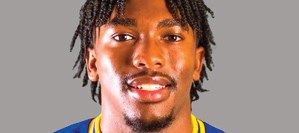NUMBERS REMAIN HISTORICALLY LOW: But Major League Baseball is working to get a new generation of African American stars such as Lee Allen Jr. into the game. PHOTOS COURTESY OF PVPANTHERS.COM
For much of Lee Allen Jr.’s childhood, baseball seemed quite far from him. Major League Baseball’s Royals played in his hometown Kansas City, Missouri, but Allen – an African American who lived in the inner city – didn’t come across many baseball opportunities until late in his high school years.
In January 2020, a 17-year-old Allen was invited to one of MLB’s development programs, the DREAM Series, where for the first time he was put in front of scouts and coaches to display his skills in a competitive environment.
Four years later, Allen stood on the field at the Jackie Robinson Training Complex in Vero Beach, Fla., wearing a purple, white and gold baseball uniform representing the historically Black college Prairie View A&M University, his eyes set on a pro career.
More than 200 HBCU standouts were there for MLB’s Andre Dawson Classic, a collegiate tournament for players hoping to one day crack the major leagues – and perhaps help usher in a new generation of African American stars.
"Being able to be out here and showcase my talents in front of these scouts and other guys who’s looking at us at the next level," said Allen, now a junior infielder for the Panthers, "it feels great for me because I know that those are goals that I can reach, and they’re there."
That’s MLB’s aim as it faces historically low numbers of Black players in the majors. A study done by The Institute for Diversity and Ethics in Sport at Central Florida found African American players represented just 6.2% of players on MLB opening day rosters in 2023, down from 7.2% in 2022. Both figures were the lowest since the study began in 1991, when 18% of MLB players were Black.That’s also the lowest percentage of African American participation among four of the five major professional sports – NBA, NFL, MLB, MLS – outside of the National Hockey League, where more than 90% of its players are white. MLB has tried to address that with a series of grassroots diversity initiatives.
"We are really doubling down on what we’ve done," said Del Matthews, MLB’s vice president of baseball development, "because we are producing kids that are going to college, that are getting internships within the sport. We see more kids playing at the Division I college baseball ranks, and we see more kids being drafted into the minor leagues. And so we’re just flooding that through the various programs that we’ve had."
There are signs of progress at the pro level. Between 2012 and 2021, 17.4% of first-round picks were African American players. That number spiked to 30% in 2022, when four of the first five selections were Black players for the first time ever – and all four were alumni of at least one MLB diversity initiative. In 2023, Black players made up 10 of the first 50 draft selections, or 20%.
Those gains haven’t bolstered MLB numbers yet, and even in the minors, Black participation has been slow to rise. When MLB recently announced rosters for its Spring Breakout exhibitions showcasing top minor league prospects, 9.5% of the players were Black – including 31 alums of MLB’s diversity programs.
MLB’s pipeline begins with an annual tour of pro-style camps in various cities across the country to identify baseball potential among inner city kids. The tour has grown each year – from 12 stops when it launched in 2018 to 18 cities now – and targets kids around 13-14 years old, just before they enter high school.
"The sport has gotten so expensive that it has eliminated a lot of our kids," said Jerry Manuel, a former manager for the White Sox and Mets. "So we’ve got to do everything we can to get them back in the pipeline."
The programs are mostly funded through USA Baseball, the sport’s governing body in the United States, which pays for equipment, meals and potential travel for showcases that Matthews estimated could otherwise cost upward of $700 per event. Anywhere from 1,200 to 1,500 kids are selected each year to participate in MLB’s diversity-focused programming, including the DREAM Series, Breakthrough Series, the Hank Aaron Invitational and girls baseball/softball events. Some players attend several events per year – an opportunity that otherwise wouldn’t be feasible for many kids from lower-income families.
One of the MLB hopefuls is Termarr Johnson, who chose baseball over basketball and football – sports he said were more popular growing up in Atlanta. He participated in almost every diversity initiative MLB offered and was connected with mentors like Manuel, Ken Griffey Jr., Dave Winfield and Marquis Grissom – some of whom he can call on a whim for advice.












No Comment